By Ron Sims, MA, Special Collections Librarian
The historical displays in the Eckenhoff Reference and Special Collections Reading Rooms featured papers, publications and manuscript material from the Founders of Northwestern University’s medical school. (*)
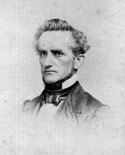 The most prolific writer of this group of physicians and surgeons was Nathan Smith Davis (1817-1904), with nearly 300 papers. His primary interests were medical education in the United States and temperance. He is credited with founding the American Medical Association (1847), Mercy Hospital (1851), Chicago Medical Society (1850), Chicago Academy of Sciences (1857), Medical Department of Lind University (1859), Union College of Law (1859), Washingtonian Home for the Cure of Inebriates of Chicago (1863), Chicago medical examiner (1860), Journal of the American Medical Association (1883), American Medical Temperance Society (1891) and more.
The most prolific writer of this group of physicians and surgeons was Nathan Smith Davis (1817-1904), with nearly 300 papers. His primary interests were medical education in the United States and temperance. He is credited with founding the American Medical Association (1847), Mercy Hospital (1851), Chicago Medical Society (1850), Chicago Academy of Sciences (1857), Medical Department of Lind University (1859), Union College of Law (1859), Washingtonian Home for the Cure of Inebriates of Chicago (1863), Chicago medical examiner (1860), Journal of the American Medical Association (1883), American Medical Temperance Society (1891) and more.
In the exhibit, Dr. Davis is represented by his History of medical education and institutions in the United States (1851) [1]; the Introductory address for the newly- founded Medical Department of Lind University which took place on October 10, 1859 [2]; his address for laying of the corner stone at the new Mercy Hospital on July 25, 1869 [3]; and by his handwritten letter “To A. H. Wilde, Registrar,” containing a brief history of the founding of the Medical Department of Lind University, which was later reorganized as the Chicago Medical College in 1863 and subsequently affiliated with Northwestern University in 1869.
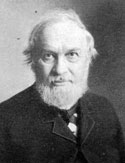 For fifty years, Edmund Andrews (1824-1904) was a towering figure in the medical profession in the “west.” As a demonstrator of anatomy in the medical school at Michigan, he developed keen skills with both pen and knife. He was chief surgeon at Mercy Hospital, Northwestern’s first teaching hospital. With a commission, as major and surgeon during the American Civil War, he served in many of the battles in Tennessee and Mississippi. Records of these efforts were published in the Chicago medical examiner from 1862-1865. He was the first to employ antiseptic methods in Chicago. His work, The early glacial history of North America was a widely used text-book, and influenced his sons and grandsons in geology (they were all surgeons, as well). One of Dr. Andrews’s major interests was the use of anesthesia in surgery.
For fifty years, Edmund Andrews (1824-1904) was a towering figure in the medical profession in the “west.” As a demonstrator of anatomy in the medical school at Michigan, he developed keen skills with both pen and knife. He was chief surgeon at Mercy Hospital, Northwestern’s first teaching hospital. With a commission, as major and surgeon during the American Civil War, he served in many of the battles in Tennessee and Mississippi. Records of these efforts were published in the Chicago medical examiner from 1862-1865. He was the first to employ antiseptic methods in Chicago. His work, The early glacial history of North America was a widely used text-book, and influenced his sons and grandsons in geology (they were all surgeons, as well). One of Dr. Andrews’s major interests was the use of anesthesia in surgery.
In the exhibit, Dr. Andrews is represented by his original contribution published in the Chicago medical examiner, March 1864 entitled About pocket surgical cases [4] and another from the November 1868 issue entitled The oxygen mixture, a new anaesthetic combination [5].
 Hosmer A. Johnson (1822-1891), also a graduate of Michigan, was the first intern at Mercy Hospital, studying with Dr. Davis who was then teaching at Rush Medical College. During the Civil War, he was assigned to the board of examining surgeons. He was the first president of the newly established Medical Department of Lind University, holding a variety of teaching positions: materia medica, physiology, histology, pathology, clinical medicine and principles and practice of medicine throughout his 30 plus years of association with Northwestern. His work is represented by a philosophical treatise on life written in 1876, aptly titled Life: what do we know about it?[6] and his publication, Influence of the work of the Illinois medical practice act upon medical education [7].
Hosmer A. Johnson (1822-1891), also a graduate of Michigan, was the first intern at Mercy Hospital, studying with Dr. Davis who was then teaching at Rush Medical College. During the Civil War, he was assigned to the board of examining surgeons. He was the first president of the newly established Medical Department of Lind University, holding a variety of teaching positions: materia medica, physiology, histology, pathology, clinical medicine and principles and practice of medicine throughout his 30 plus years of association with Northwestern. His work is represented by a philosophical treatise on life written in 1876, aptly titled Life: what do we know about it?[6] and his publication, Influence of the work of the Illinois medical practice act upon medical education [7].
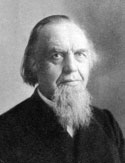 A man of diverse interests, John H. Hollister (1824-1911) was a member of the faculty for 40 years, conducting a large private practice while busily engaged in medical society affairs. He was equally engaged in Christian faith matters, as a church leader, Sunday school teacher, and advocate for Native Americans and the plight of the newly-freed slave population. He was the only Founder to write an autobiography, Memories of eighty years (1912) [8].
A man of diverse interests, John H. Hollister (1824-1911) was a member of the faculty for 40 years, conducting a large private practice while busily engaged in medical society affairs. He was equally engaged in Christian faith matters, as a church leader, Sunday school teacher, and advocate for Native Americans and the plight of the newly-freed slave population. He was the only Founder to write an autobiography, Memories of eighty years (1912) [8].
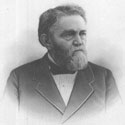 William Heath Byford (1817-1890) was a pioneer in the medical education of women and was one of the organizers of the Woman’s Hospital Medical College, later Northwestern University Woman’s Medical School. He was a prolific writer, primarily on obstetrics and gynecology, and his first paper in 1847 was on caesarean section. In the exhibit, Dr. Byford is represented by his textbook Practice of medicine and surgery applied to the diseases and accidents incident to women (1865) [9] and “Doctoral address delivered at the commencement of the Woman’s Medical College” [10].
William Heath Byford (1817-1890) was a pioneer in the medical education of women and was one of the organizers of the Woman’s Hospital Medical College, later Northwestern University Woman’s Medical School. He was a prolific writer, primarily on obstetrics and gynecology, and his first paper in 1847 was on caesarean section. In the exhibit, Dr. Byford is represented by his textbook Practice of medicine and surgery applied to the diseases and accidents incident to women (1865) [9] and “Doctoral address delivered at the commencement of the Woman’s Medical College” [10].
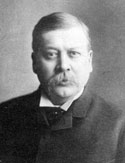 The first Professor of Surgical Anatomy and Operative Surgery, Ralph Nelson Isham (1831-1904) acquired a stellar reputation as a teacher and an expert surgical operator. During the Civil War, he was a contract surgeon and an organizer of the United States Sanitary Commission. He was appointed chief surgeon at Chicago's Marine Hospital, which had temporarily become a military hospital, and served as the hospital administrator after the War. He went on to become chief surgeon for the Chicago and North Western Railway and consulting surgeon at Cook County, Presbyterian and Passavant hospitals and a major in the Illinois National Guard. He was the first secretary of the medical school faculty.
The first Professor of Surgical Anatomy and Operative Surgery, Ralph Nelson Isham (1831-1904) acquired a stellar reputation as a teacher and an expert surgical operator. During the Civil War, he was a contract surgeon and an organizer of the United States Sanitary Commission. He was appointed chief surgeon at Chicago's Marine Hospital, which had temporarily become a military hospital, and served as the hospital administrator after the War. He went on to become chief surgeon for the Chicago and North Western Railway and consulting surgeon at Cook County, Presbyterian and Passavant hospitals and a major in the Illinois National Guard. He was the first secretary of the medical school faculty.
Dr. Isham is represented in the exhibit by his Report on the condition of camps and hospitals at Cairo and vicinity, Paducah and St. Louis authored with the Reverend William W. Patton [11]; and his handwritten minutes of the third faculty meeting on March 22, 1859.
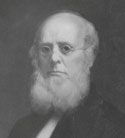 David Rutter (1800-1865) was the oldest member of the Founders and sustained the younger men during the establishment of the new medical college. Dr. Rutter was given the title of Emeritus Professor of Obstetrics and Diseases of Women. He was a devoted adherent of Abraham Lincoln and when the President was assassinated he was so deeply affected that he was stricken with apoplexy and died on April 16, 1865.
David Rutter (1800-1865) was the oldest member of the Founders and sustained the younger men during the establishment of the new medical college. Dr. Rutter was given the title of Emeritus Professor of Obstetrics and Diseases of Women. He was a devoted adherent of Abraham Lincoln and when the President was assassinated he was so deeply affected that he was stricken with apoplexy and died on April 16, 1865.
As Isabella Hollister Martin reminds us in her Remarks at [the] unveiling ceremony of her father’s portrait in 1927 … “do not remember these men solely as they may have appeared to you in these latter years, as men of achievement and assured position, but think of them also as young men filled with youthful enthusiasm for the fulfillment of a wonderful dream … [r]emember as you think of them that it is the courage and vision of yesterday that underlies and makes possible the courage and vision of tomorrow.”
(*) NOTE: The exhibit on the Medical School Founders' Papers, Publications, and Manuscripts (described here) is no longer on display. For more information on the medical school founders and their publications, please contact Galter Health Sciences Library Special Collections at ghsl-specialcollections@northwestern.edu.
[1] Nathan Smith Davis, History of Medical Education. S.C. Griggs, Chicago, 1851
[2] Chicago medical examiner, Jan. 1860; 1(1):1-22
[3] Chicago medical examiner, Sep, 1869; 10(9): 525
[4] Chicago medical examiner, Mar. 1864; 5(3): 129
[5] Chicago medical examiner, Nov. 1868; 9(11), 656
[6] Hosmer A. Johnson, Life: what do we know about it? Chicago, Jansen, McClurg, 1876.
[7] Chicago medical journal and examiner, 1888; 52:327-330
[9] William Heath Byford, Practice of medicine and surgery, applied to the diseases and accidents incident to women. Philadelphia: Lindsay & Blakiston, 1865.
[10] Chicago medical journal and examiner, June 1884;48(6): 561-574.
[11] Ralph Nelson Isham and William W. Patton, Report on the condition of camps and hospitals at Cairo and vicinity, Paducah and St. Louis. Chicago: Dunlop, Sewell & Spalding, 1861
Updated: March 5, 2020